August 2023
Exploring the Diverse Causes of Foot Pain
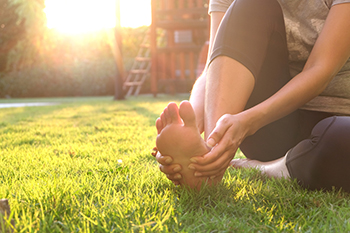
Foot pain, a common yet intricate ailment, can be traced back to an array of underlying causes. Improper footwear that that is too tight or lacking arch support can exert undue pressure on the feet's delicate structures. Overuse or repetitive motions, which are common in activities such as running or standing for prolonged periods, can lead to strain and discomfort. Foot injuries, whether from accidents or sports-related incidents, may result in lingering pain. Medical conditions, such as plantar fasciitis, arthritis, or neuropathy, can manifest in foot discomfort. Additionally, having poor foot mechanics, such as overpronation or flat feet, can also contribute to existing foot pain. Acknowledging the nature of foot pain empowers individuals to address these causes effectively, promoting a path toward lasting comfort and well-being. If you have any type of foot pain, it is strongly suggested that you speak to a podiatrist as quickly as possible who can properly diagnose and treat various problems.
Foot Pain
Foot pain can be extremely painful and debilitating. If you have a foot pain, consult with Steven Spivak, DPM from Mount Holly Family Footcare. Our doctor will assess your condition and provide you with quality foot and ankle treatment.
Causes
Foot pain is a very broad condition that could be caused by one or more ailments. The most common include:
- Bunions
- Hammertoes
- Plantar Fasciitis
- Bone Spurs
- Corns
- Tarsal Tunnel Syndrome
- Ingrown Toenails
- Arthritis (such as Gout, Rheumatoid, and Osteoarthritis)
- Flat Feet
- Injury (from stress fractures, broken toe, foot, ankle, Achilles tendon ruptures, and sprains)
- And more
Diagnosis
To figure out the cause of foot pain, podiatrists utilize several different methods. This can range from simple visual inspections and sensation tests to X-rays and MRI scans. Prior medical history, family medical history, and any recent physical traumatic events will all be taken into consideration for a proper diagnosis.
Treatment
Treatment depends upon the cause of the foot pain. Whether it is resting, staying off the foot, or having surgery; podiatrists have a number of treatment options available for foot pain.
If you have any questions, please feel free to contact our office located in Lumberton, NJ . We offer the newest diagnostic and treatment technologies for all your foot care needs.
Exploring Causes of Swollen Feet
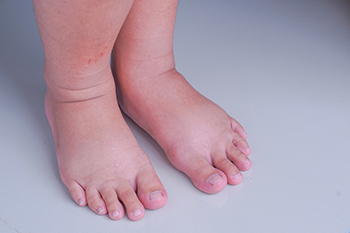
Swollen feet, an uncomfortable and often puzzling issue, can cast a shadow over daily activities. The causes behind this condition can be as diverse as they are unexpected. Prolonged periods of standing or sitting, especially in hot weather, can lead to fluid accumulation in the lower extremities. Pregnancy, with its hormonal shifts and increased pressure on blood vessels, is a common culprit. Health conditions such as heart, kidney, or liver problems can disrupt the body's fluid balance, resulting in swelling. Injuries, infections, and certain medications can also contribute to swelling. Recognizing swollen feet is relatively simple, which is easy to notice as the feet are puffy and tight. Additionally, there can be an indentation in the skin, indicating the feet are swollen. Understanding the underlying triggers empowers individuals to make informed choices, seek medical guidance from a podiatrist, and embrace measures that foster foot health and overall well-being. If you have swollen feet, it is strongly suggested that you speak with a podiatrist who can offer effective treatment methods.
Swollen feet can be a sign of an underlying condition. If you have any concerns, contact Steven Spivak, DPM of Mount Holly Family Footcare. Our doctor can provide the care you need to keep you pain-free and on your feet.
Swollen feet are a common ailment among pregnant women and people who stand or sit for extended periods. Aging may increase the possibility of swollen feet and patients who are obese often notice when their feet are swelling too. There may be medical reasons why swollen feet occur:
- Phlebitis - A condition that causes the veins to become inflamed and can also cause leg pain.
- Liver disease - This may lead to low blood levels of albumin which is a protein. This can cause fluid in the blood to pass into the tissues and several areas of the body can become swollen.
- Heart failure - When the heart doesn’t pump properly the blood that is normally pumped back to the heart can pool in the veins of the legs causing swollen feet.
- Kidney disease - One of the main functions of the kidneys is releasing excess fluid in the body. This type of condition can make it difficult for the kidneys to function properly, and as a result the feet may become swollen.
- Deep-vein thrombosis (DVT)- This is a serious condition where blood clots form in the veins of the legs. They can block the return of blood from the legs to the heart which may cause the feet to swell. It is important to be treated by a podiatrist if this condition is present.
Swollen feet can also be caused by bone and tendon conditions, including fractures, arthritis, and tendinitis. Additionally, there may be skin and toenail conditions and an infection may cause the feet to swell. Patients who take medicine to treat high blood pressure may be prone to getting swollen feet.
Many patients elevate their feet to help relieve the swelling and this is generally a temporary remedy. When a podiatrist is consulted the reason behind the swelling can be uncovered and subsequently treated.
If you have any questions please feel free to contact our office located in Lumberton, NJ . We offer the newest diagnostic tools and technology to treat your foot and ankle needs.
It Is Essential to Practice Toe Stretches
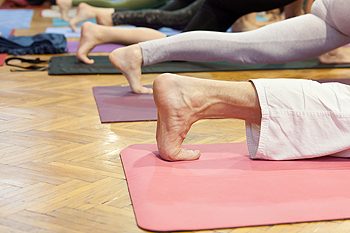
The toes play a crucial role in our everyday movements, providing balance and stability. However, they are often overlooked when it comes to stretching and exercise routines. Just like any other part of our body, the toes can benefit from regular stretching to improve flexibility and prevent discomfort. Toe stretches can be simple yet effective, promoting blood circulation and relieving tension in the feet. One easy stretch involves sitting comfortably with feet flat on the floor and toes spread apart as much as possible. Hold this position for a few seconds and repeat it several times. Another beneficial stretch is gently pulling the toes back towards the body while keeping the foot flat on the ground. Regular toe stretching can be particularly beneficial for individuals who spend long hours on their feet, wear tight footwear, or suffer from conditions such as plantar fasciitis. If you would like additional information about various toe stretches, it is suggested that you consult with a podiatrist.
Why Stretching Is Important for Your Feet
Stretching the feet is a great way to prevent injuries. If you have any concerns with your feet consult with Steven Spivak, DPM from Mount Holly Family Footcare. Our doctor will assess your condition and provide you with quality foot and ankle treatment.
Stretching the Feet
Stretching the muscles in the foot is an important part in any physical activity. Feet that are tight can lead to less flexibility and make you more prone to injury. One of the most common forms of foot pain, plantar fasciitis, can be stretched out to help ease the pain. Stretching can not only ease pain from plantar fasciitis but also prevent it as well. However, it is important to see a podiatrist first to determine if stretching is right for you. Podiatrists can also recommend other ways to stretch your feet. Once you know whether stretching is right for you, here are some excellent stretches you can do.
- Using a foam roller or any cylindrical object (a water bottle or soda can will do), roll the object under your foot back and forth. You should also exert pressure on the object. Be sure to do this to both feet for a minute. Do this exercise three times each.
- Similar to the previous exercise, take a ball, such as a tennis ball, and roll it under your foot while seated and exert pressure on it.
- Grab a resistance band or towel and take a seat. If you are using a towel, fold it length wise. Next put either one between the ball of your foot and heel and pull with both hands on each side towards you. Hold this for 15 seconds and then switch feet. Do this three times for each foot.
- Finally hold your big toe while crossing one leg over the other. Pull the toe towards you and hold for 15 seconds. Once again do this three times per foot.
It is best to go easy when first stretching your foot and work your way up. If your foot starts hurting, stop exercising to ice and rest the foot. It is advised that you then see a podiatrist for help.
If you have any questions, please feel free to contact our office located in Lumberton, NJ . We offer the newest diagnostic and treatment technologies for all your foot care needs.
Eczema and Blisters on the Feet
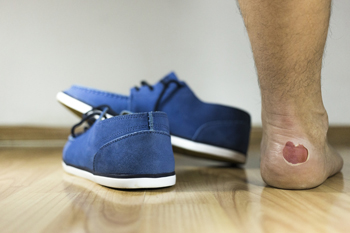
Foot dyshidrotic eczema, also known as pompholyx, is a skin condition characterized by small, intensely itchy blisters that appear on the soles of the feet and edges of the toes. This condition tends to flare up for a few weeks and in some cases, can be chronic. It is most common in adults aged 20-40, with a higher prevalence among females. Symptoms of foot dyshidrotic eczema include a burning or prickling sensation on the skin, followed by the sudden eruption of tiny blisters that may weep and become infected. This condition can cause pain, itching, fluid-filled blisters, sweaty skin, dry and flaky skin after blisters clear, and possible dark spots for individuals with darker skin tones. The exact cause of foot dyshidrotic eczema is unknown, but it is thought to be genetic and can be linked to hypersensitivity to certain allergens, such as exposure to metals or fungal infections like athlete's foot, and excessively sweaty feet. Stress and warm weather may also lead to flare-ups. If you have anything resembling this condition, it is strongly suggested that you make an appointment with a podiatrist as soon as possible for a proper diagnosis and treatment.
Blisters are prone to making everyday activities extremely uncomfortable. If your feet are hurting, contact Steven Spivak, DPM of Mount Holly Family Footcare. Our doctor can provide the care you need to keep you pain-free and on your feet.
Foot Blisters
Foot blisters develop as a result of constantly wearing tight or ill-fitting footwear. This happens due to the constant rubbing from the shoe, which can often lead to pain.
What Are Foot Blisters?
A foot blister is a small fluid-filled pocket that forms on the upper-most layer of the skin. Blisters are filled with clear fluid and can lead to blood drainage or pus if the area becomes infected.
How Do Blisters Form?
Blisters on the feet are often the result of constant friction of skin and material, usually by shoe rubbing. Walking in sandals, boots, or shoes that don’t fit properly for long periods of time can result in a blister. Having consistent foot moisture and humidity can easily lead to blister formation.
Prevention & Treatment
It is important to properly care for the affected area in order to prevent infection and ease the pain. Do not lance the blister and use a Band-Aid to provide pain relief. Also, be sure to keep your feet dry and wear proper fitting shoes. If you see blood or pus in a blister, seek assistance from a podiatrist.
If you have any questions, please feel free to contact our office located in Lumberton, NJ . We offer the newest diagnostic and treatment technologies for all your foot care needs.
Foot Problems From Diabetes
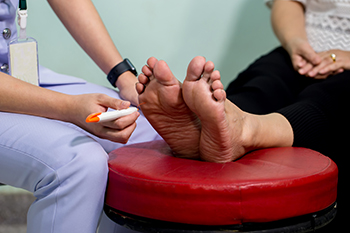
Many people with diabetes develop foot pain that directly results from their disease. One such condition is diabetic neuropathy, which is caused by nerves that have been damaged by high levels of blood sugar. The cause of severe foot pain is known as focal neuropathy, which affects one nerve at a time. On the other hand, peripheral neuropathy affects all the nerves from the spine to the feet. Factors that make diabetic foot pain more likely to occur include uncontrolled blood sugar levels, poor blood flow to the feet, plaque buildup in the arteries and veins, and genetics. In addition, the risk of diabetic foot pain increases with alcohol abuse and smoking. Having diabetic neuropathy can lead to difficulty walking, foot ulcers, and frequent foot infections. A regular foot hygiene routine is the best way to prevent these conditions from forming or worsening. For more information about foot pain related to diabetes, it is suggested that you make an appointment with a podiatrist.
Diabetic foot care is important in preventing foot ailments such as ulcers. If you are suffering from diabetes or have any other concerns about your feet, contact Steven Spivak, DPM from Mount Holly Family Footcare. Our doctor can provide the care you need to keep you pain-free and on your feet.
Diabetic Foot Care
Diabetes affects millions of people every year. The condition can damage blood vessels in many parts of the body, especially the feet. Because of this, taking care of your feet is essential if you have diabetes, and having a podiatrist help monitor your foot health is highly recommended.
The Importance of Caring for Your Feet
- Routinely inspect your feet for bruises or sores.
- Wear socks that fit your feet comfortably.
- Wear comfortable shoes that provide adequate support.
Patients with diabetes should have their doctor monitor their blood levels, as blood sugar levels play such a huge role in diabetic care. Monitoring these levels on a regular basis is highly advised.
It is always best to inform your healthcare professional of any concerns you may have regarding your feet, especially for diabetic patients. Early treatment and routine foot examinations are keys to maintaining proper health, especially because severe complications can arise if proper treatment is not applied.
If you have any questions please feel free to contact our office located in Lumberton, NJ . We offer the newest diagnostic and treatment technologies for all your foot and ankle needs.





